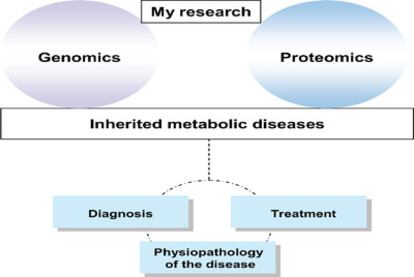The importance of diagnosis and research on new therapies for rare diseases
My research into inherited metabolic diseases (IMD) contributes to this collective effort. Up to now, more than 500 IMD have been described, and their effects generally range from severe presentations in the first 28 days after birth, to milder presentations that become apparent later on in life. There is a great diversity of symptoms, resulting overall from variations in the observable physical or biochemical characteristics of each individual.
Every cell contains thousands of molecules, each with an important cellular function. DNA molecules - the building blocks of life - act as carriers of genetic information. DNA information can be copied into RNA molecules in a process called transcription, and proteins can be synthesized using the information in RNA as a template. A domino effect is caused by a change in DNA sequence (the order of nucleotides that make up a given segment of a DNA molecule) which is then transcribed in a change in the RNA molecule and results in a mutant protein that cannot carry out its cellular function, and therefore causes a disease.
The study of DNA and proteins has been part of my research in three IMD: adenosine deaminase (ADA) deficiency, propionic acidemia (PA) and methylmalonic acidemia (MMA). ADA deficiency is the pathology affecting the so-called 'bubble children' in which the immune system is not functional and is extremely vulnerable to infectious diseases, so the children need to live in a sterile environment. PA and MMA are the two more frequent diseases of one group of IMD called organic acidurias, characterized by the increased concentrations of two organic acids - propionic acid in PA and methylmalonic acid in MMA patients.
Molecular analyses of 'bubble children' and patients with PA have been carried out to identify DNA mutations that cause disease. It has been discovered that ADA is bound to a protein called CD26, forming a protein complex in humans, but not in mice or rats. The interaction between one protein and another has been described as similar to placing a key in a lock, and such interactions are extremely important in all the biological processes of a living cell. The amino acid residues of ADA involved in this interaction have been identified by using different technologies. It is worth noting that the observation of a healthy individual with an ADA protein that does not bind to CD26 is relevant, because it suggests that ADA-CD26 interaction is not important for the immune function in humans, as is certainly the case in mice and perhaps some other species.
The term 'proteomics' refers to all proteins expressed by a genome - the full DNA sequence of an organism - and one of its goals is the identification of these proteins. Proteomic technologies are important in allowing us to obtain a general view of protein profiles in healthy and pathologic cells and tissues. Examining MMA disease in this way has revealed the increased expression of several proteins which are involved in the production of highly reactive molecules called reactive oxygen species (ROS), and other proteins which participate in the process of apoptosis, also known as programmed cell death. ROS are generated within a cell as it respires; however when they are not eliminated by the usual defence systems (several antioxidant proteins which act against ROS damage), ROS levels can increase dramatically and may result in significant damage to cell structures. Studies of patients with MMA have shown an increase in ROS, suggesting that oxidative damage to their nervous systems may in part cause the symptoms.
It is interesting to note that oxidative damage has also been described in neurodegenerative, vascular and chronic-inflammatory diseases and cancer. Now, my research is focused on the study of molecular mechanisms that govern cell death. The importance of these studies lies in the possible application of new antioxidant therapies in these patients carrying these defective genes.
Investigating IMD allows me the opportunity to research and develop different approaches to study the molecular basis and the physiopathology of these diseases. The goal, of course, is to better diagnose and treat these patients in order to improve their quality of life.

Tu suscripción se está usando en otro dispositivo
¿Quieres añadir otro usuario a tu suscripción?
Si continúas leyendo en este dispositivo, no se podrá leer en el otro.
FlechaTu suscripción se está usando en otro dispositivo y solo puedes acceder a EL PAÍS desde un dispositivo a la vez.
Si quieres compartir tu cuenta, cambia tu suscripción a la modalidad Premium, así podrás añadir otro usuario. Cada uno accederá con su propia cuenta de email, lo que os permitirá personalizar vuestra experiencia en EL PAÍS.
¿Tienes una suscripción de empresa? Accede aquí para contratar más cuentas.
En el caso de no saber quién está usando tu cuenta, te recomendamos cambiar tu contraseña aquí.
Si decides continuar compartiendo tu cuenta, este mensaje se mostrará en tu dispositivo y en el de la otra persona que está usando tu cuenta de forma indefinida, afectando a tu experiencia de lectura. Puedes consultar aquí los términos y condiciones de la suscripción digital.




























































